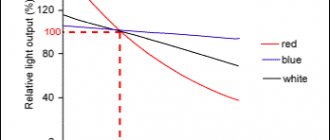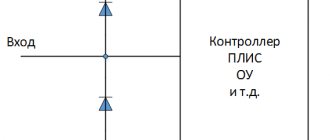Electrician in the house
Encyclopedia about electricity from A to Z
Masters catalog
Find the best master or company in your city
The evolution of lighting devices is not yet complete
Every day, without thinking, we all use such a wonderful thing as electric lighting. Lamps have become as integral a part of everyday life for us as toothbrushes, but few people remember and know how the development of lighting devices actually took place, whose contribution to the development of the electric power industry was the most significant, and how the Americans once again “heated up hands" on the research of all mankind.
So, the topic of today's narrative is the history of illumination, as it is, with the voicing of facts and dates behind which lie great discoveries and the tireless work of great inventors.
- Pre-electric era Playing with fire
- Main historical milestones of the era of electricity and epilogue
The very beginning, incandescent lamp
The history of electric lighting began long before Thomas Edison, first in 1879, and then again a year later in 1880, patented his incandescent lamp and began to popularize it. English inventors showed that electric light could be produced using an arc lamp. People saw the first electric light in 1835. After that, for another 40 years, scientists from all over the world worked to improve the incandescent lamp and tried different filaments (the part of the lamp that, when an electric current passes through it, heats up and produces light) and lamp atmospheres (whether to use a vacuum or fill the lamp with an inert gas to the thread did not burn out so quickly).
These early incandescent light bulbs had a very short lifespan, were too expensive to mass produce, and consumed a lot of energy.
When Edison and his Menlo Park followers began to study the issue of artificial lighting, they focused on improving the filament itself. They tried to choose the best material, carbon was the first, then platinum, then the researchers returned to carbon again. By the end of October 1879, Edison's team had created a light bulb made from charred cotton filament that could glow for 14.5 hours.
The team continued to experiment with filaments until they settled on one type of bamboo. Such bulbs could burn for up to 1200 hours. This filament became the standard for Edison's light bulb for the next ten years. Edison also made other improvements to incandescent lamps, he proposed pumping out all the air from the bulb so that the filament would not burn out as quickly, and he also introduced a standard for how to connect the lamp to the network by screwing in.
It is impossible to talk about the history of the light bulb without remembering William Sawyer and Abon Man, who received a US patent for incandescent light bulbs. There was also Joseph Swan, who received a patent for an incandescent lamp in England. There was a lot of debate at the time about whether Edison's incandescent light bulb violated all these people's patents. But, in the end, Edison's company merged with the Thomson-Houston Electric company, which produced lamps under the Sawyer-Man patent and became known as General Electric. This company was then joined by the English company of Joseph Swan.
Edison's contribution to the history of electric lighting is very large. He did not stop at improving the incandescent lamp. He developed a number of inventions that made the use of light bulbs more practical. Edison modeled his lighting technology on the existing gas system.
In 1882, in London, he showed that electricity could be distributed from a central generator to desired locations using electrical wires and pipes. At the same time, he focused on increasing energy production. The first commercial power station, Pearl Street Station, was developed in lower Manhattan. Additionally, to track how much energy each customer used, Edison developed the first electric meter.
While Edison was working on his lighting system, other inventors continued to make small strides in improving the filament and increasing the efficiency of the light bulb. The next big change in the incandescent lamp came with the invention of the tungsten filament by European inventors in 1904. The new lamps burned longer and had a brighter light compared to carbon lamps. In 1913, Irving Langmore discovered that it was better to use an inert gas such as nitrogen instead of a vacuum. This doubled the efficiency of the incandescent lamp. Over the next 40 years, scientists continued to make small improvements that increased the lamp's efficiency and reduced energy consumption. But in the 50s, scientists found that only 10 percent of the energy is used for light, the rest is spent on heat. Then they switched to other solutions. The lighting story didn't end there.
Major historical milestones of the era of electricity
At the end of the century, electrical energy became dominant in everything; industry operates on it; without electricity, it is impossible to imagine the development of the world. Everything runs on this energy, which is indispensable for the modern world. So lighting is a small part of the achievements, although an important one; the halogen cycle will soon be opened (year 1913). It is difficult to predict what the lighting of the future will be like; today science and industry are moving side by side by leaps and bounds. After incandescent lamps and gas-filled lamps, we have already become acquainted with halogen and fluorescent lamps and other sources of radiation. Great demand requires an inexpensive option for lighting fixtures; LED lamps and strips are rapidly entering our everyday lives; consumers are already familiar with phosphors and xenon lamps. The future will tell what awaits us tomorrow; the era of modern use of electricity has just begun.
Fluorescent lamps
In the 19th century, two Germans, glassblower Heinrich Geissler and physician Plücker, discovered that they could produce light by removing all the air from a long glass tube and passing a current through it. This invention became known as the Heusler tube. However, HID lamps did not gain popularity until the early twentieth century, when researchers began looking for ways to improve lighting efficiency. HID lamps have become the basis of many lighting technologies, including neon lamps, low-pressure lamps, sodium lamps used in floodlights, and fluorescent lamps.
Thomas Edison and Nikola Tesla also experimented with gas-discharge lamps in the 1890s, but it never came to industrial production. A real breakthrough in this area was made by Peter Cooper Hewitt in the early 1900s. He became one of the inventors of the fluorescent lamp. Hewitt produced the blue-green light by passing an electric current through a tube of mercury vapor while switching on a ballast resistor, a device that regulates the flow of current through the lamp. These lamps were much more efficient, but they were not used because of the color of the light.
In the late 1920s, European researchers began experimenting with phosphor-coated neon tubes. Phosphor is a material that absorbs ultraviolet light and converts it into a visible white glow.
This invention sparked the development of fluorescent lamps, and as early as 1930, American companies were demonstrating fluorescent lamps to the US Navy at the New York Fair. They shined longer and were three times more efficient than conventional incandescent lamps. The need for energy-efficient lighting in American military factories led to the rapid proliferation of fluorescent lamps. By 1951, most of the light in the United States was produced by such lamps.
Then came another energy shortage, the oil crisis in 1973. This forced lighting engineers to develop fluorescent lamps that could work in residential areas. In 1974, attempts began to make such lamps more miniature. Two years later, General Electric bent a fluorescent tube into a spiral, creating the first compact fluorescent lamp (CFL). But the project was delayed because the lamps were too expensive for mass production.
The first compact fluorescent lamps appeared on the market in the mid-1980s. Their prices varied greatly in different regions due to promotions carried out by utility companies. Many of these lamps were very bulky and did not always fit into lamps. Since 1990, many improvements have been made to such lamps, the price has been reduced, and the efficiency has been improved. They are now 75% more efficient than incandescent lamps, and their service life is 10 times longer. This gave the population an incentive to use them.
Passed through to the electric age
The first devices operating on electricity appeared in 1802, the sources of this were the developments of V.V. Petrov - his search for lighting using a simple electric arc led to the invention of something unusual. It was incandescent lamps that appeared, in parallel with this work the design of the first lamps took place, the first lamp, unusual for that time, was made in England, its author Devi in the same year as Petrov. When physicist Jean Bernard Foucault replaced wood electrodes with carbon analogues, the lamp began to burn longer, but for now it was controlled manually. It has already been used in theaters and in microscopes for spot lighting, such bright lighting devices have already been used in lighthouses, but so far these were the first hesitant steps into the world of bright light with carbon electrodes.
Arc carbon lamp.
Arc lighting followed its own special path, where Chikolev and Stukkert applied their powers, quite a few arc lamps were produced by Siemens factories, and until the 80s they were used to illuminate cities and were installed in transport. When the era of arc lamps passed, they remained in searchlights and projection devices.
Our time, LED lamps
Light Emitting Diode or LED is one of the fastest growing technologies today. LEDs use semiconductors to convert electrical current into light. They are small in area, less than one square millimeter, and emit light in a specific direction, reducing the need for reflectors and diffusers.
This is the most efficient light source on the market. LED lamps consume minimal energy and can last up to ten years. This is no longer the history of electric lighting, but its future. We will definitely look at the history of the development of LED lighting in one of our next articles.
The advent of electricity in Russia
Some time after the introduction of the term “electricity,” this phenomenon began to be studied in many countries. The beginning of change can be considered the appearance of lighting. In what year did electricity appear in Russia? According to public outcry, this date is 1879. It was then that the Liteyny Bridge was first electrified using lamps in St. Petersburg.
But a year earlier in Kyiv, in one of the railway workshops, electric lights were installed. Therefore, the date of the appearance of electricity in Russia is a somewhat controversial issue. But since this event went unnoticed, the official date can be considered the lighting of the Liteiny Bridge.
But there is another version when electricity appeared in Russia. From a legal point of view, this date is January thirtieth, 1880. On this day, the first electrical engineering department appeared in the Russian Technical Society. His duties were to oversee the introduction of electricity into everyday life. In 1881, Tsarskoye Selo became the first European city to be completely illuminated.
Another significant date is May fifteenth, 1883. On this day, the Kremlin was illuminated for the first time. The event was timed to coincide with the accession to the Russian throne of Alexander III. To illuminate the Kremlin, electricians installed a small power station on Sofiyskaya Embankment. After this event, lighting first appeared on the main street of St. Petersburg, and then in the Winter Palace.
In the summer of 1886, by decree of the emperor, the Electric Lighting Society was established. It was engaged in the electrification of the entire St. Petersburg and Moscow. And in 1888, the first power plants began to be built in the largest cities. In the summer of 1892, the debut electric tram was launched in Russia. And in 1895 the first hydroelectric power station appeared. It was built in St. Petersburg, on the river. Bolshaya Okhta.
And in Moscow, the first power plant appeared in 1897. It was built on Raushskaya embankment. The power plant generated three-phase alternating current. And this made it possible to transmit electricity over long distances without significant loss of power. In other Russian cities, power plants began to be built at the dawn of the twentieth century, before the First World War.
conclusions
The entire history of the development of electric lighting, from the very beginning to the present time, has passed in a couple of hundred years. Just think, two hundred years ago people lit rooms with fire and had no idea what electricity was. It's amazing how we were able to achieve this in just a few generations. And that's not all. The history of the development of the light bulb will continue and continue its LED lighting.
If you find an error, please select a piece of text and press Ctrl+Enter.
Related posts:
- Pros and cons of LED lighting
22.02.2016
- LED lamp markings
27.07.2016
- LED lamp voltage
01.08.2016
- Safety of LED lamps
05.08.2016
Rate this article:
( 4 ratings, average: 4.75 out of 5)
Tweet Pin It
History of electricity
If you start to understand when electricity appeared, you need to remember the Greek philosopher Thales. It was he who first drew attention to this phenomenon in 700 BC. e. Thalles discovered that when amber was rubbed against wool, the stone began to attract light objects.
In what year did electricity appear? After the Greek philosopher, no one studied this phenomenon for a long time. And knowledge in this area did not increase until 1600. In this year, William Gilbert introduced the term “electricity” by studying magnets and their properties. Since that time, scientists have begun to intensively study this phenomenon.
Advantages and disadvantages.
The advantages of an incandescent lamp are as follows: low initial cost of the lamp and the equipment necessary for it, compactness, due to which it is well suited for regulating the luminous flux, reliable operation at low temperatures and a fairly high light output for its size. The disadvantages, which in some circumstances can outweigh the advantages, include low light efficiency, high operating temperature and noticeable fluctuations in light output when the supply voltage changes.
Public lighting
The total amount of artificial light (especially street light) is sufficient for cities to be clearly visible at night, both from the air and from space. This light is the source of light pollution that burdens astronomers and others.
In this composite image taken in October 2012, artificial lights highlight highly developed or populated areas of the Earth's surface, including the coasts of Europe, the eastern United States, India, Japan and South Korea.
Expected lamp life
The expected life for many types of lamps is defined as the number of hours of operation at which 50% of them fail, that is, the average life of the lamps. Manufacturing tolerances of as little as 1% can result in a 25% variation in lamp life, so typically some lamps fail well before their rated life and some last much longer. For LEDs, lamp life is defined as the operating time at which 50% of lamps have experienced a 70% reduction in light output.
Some types of lamps are also sensitive to switching cycles. In areas with frequent switching, such as bathrooms, the lamp life may be shorter than stated on the box. Compact fluorescent lamps are particularly sensitive to switching cycles.
Altai 21st Century Foundation
“Stories about the Russian Championship” - read interesting articles from this book, with continuations! You will learn about the real contribution of Russian scientists and inventors to the development of world science and technology.
Electric light has long ceased to seem unusual. Dispelling the darkness with the rays of wonderful lamps, we gratefully remember those who made electricity generate light.
Electric light was born in the laboratory of St. Petersburg academician Vasily Vladimirovich Petrov, the great physicist of his time.
Studying the effect of electric current with the help of a huge battery of elements he created, which was a record for its power at that time, Petrov carried out such an experiment. Having connected two charcoals to the battery, he touched them to each other. A spark flashed. Petrov moved the coals apart so that a small gap formed between them. But the spark did not go out, it turned into a bright flame, connecting the coals with a sparkling bridge.
So on November 23, 1802, the electric arc was discovered, one of the forms of gas discharge, which at one time attracted the attention of Lomonosov.
In 1803, the printing house of the State Medical College published the book “News about the galvanic-voltaic experiments carried out by professor of physics Vasily Petrov, using a huge battery, sometimes consisting of 4,200 copper and zinc circles, and located at the St. Petersburg Medical-Surgical Academy.” .
Much of what is included in modern electrical engineering was first described here: wire insulation invented by the author, the role of the internal resistance of a battery, the effect of polarization on battery performance.
In the seventh article, Petrov described in detail the electric arc he discovered. Here the scientist also reported that from this arc “the dark peace can be illuminated.”
Now we are talking about Petrov as a pioneer of electric lighting.
Here it is appropriate to remember another work of Petrov. This is his research into the phenomenon of luminescence - “cold glow”. Vasily Petrov did many experiments studying this phenomenon.
It would seem that these works were not directly related to electricity. But these days, the phenomenon of luminescence, which occupied Petrov, is the basis for a new type of electric lamps - fluorescent lamps.
Petrov worked in the most difficult conditions: equipment, instruments, reagents - all this had to be obtained at enormous cost; effort.
Even after breaking through the wall of bureaucratic inertia, Petrov created an excellent laboratory and made great discoveries in it, the attitude of official, “official” science towards him did not change.
Academy of Sciences, reporting the discovery in 1804; galvanic fire, did not find it necessary to name the name of V.V. Petrov, the creator of the arc.
People abroad could not help but know about the discovery of the electric arc in Russia. In addition to the above-mentioned little book, the arc was written about back in 1802 in the Petersburg Gazette and in the appendix to the Technological Journal of the Academy of Sciences for 1806.
And yet, abroad, Petrov’s discovery was attributed to Davy, who only in 1811 lit an electric arc and called it “voltaic.” Official science did not defend the priority of the Russian scientist. Moreover, shortly before his death he was fired from the Academy with a paltry pension.
Nowadays, Petrov’s work has received national recognition.
In 1934, the centennial anniversary of the death of “the first Russian electrical engineer, Academician V.V. Petrov, who discovered the phenomenon of the voltaic arc in 1802, several years before Davy, and predicted the use of this phenomenon in technology (metal welding, electrometallurgy)” was solemnly celebrated. , as stated in the decree of the Soviet government.
In 1836, Moscow University professor Mikhail Grigorievich Pavlov prophetically wrote: “It seems that the time is not far when electricity, having become a universal means of illumination, will replace the combustion of all materials consumed for it, just as heat in water vapor has replaced an incredible amount of mechanical force. It is impossible to doubt the ability of electricity; All that is needed is the appearance of an inventive person who can adapt this wonderful fire to the expected use.”
Such people have been found. In 1849, Petrov's arc was lit on the Admiralty Tower, illuminating the streets of St. Petersburg. It was the Russian academician Boris Semenovich Jacobi who first tried to practically use electric light. The second experiment in using an arc for lighting was carried out in Kazan in 1853 by Professor Savelyev.
Getting the arc to burn steadily was difficult. It was necessary to come up with a device that would help maintain a constant gap between the coals. A manual regulator, of course, did not solve the problem. It was necessary to automate arc control.
The practical application of the arc for lighting purposes depended on the successful solution of the regulator problem.
One of the first mechanical regulators was also built by the Russian inventor L. I. Shpakovsky. In 1856, during the coronation celebrations, several “electric suns” were installed on the building of the Lefortovo Palace in Moscow.
But electric lighting by means of an arc has not yet become widespread, because... the arc required high current.
Even when dynamos appeared, the difficulties did not disappear. The fact is that each arc needed its own dynamo. The current consumed by the arcs of the structures that existed at that time was very high. In addition, the regulators were not yet reliable and simple enough.
All these difficulties were resolved again in Russia. In 1876, Russian inventor Pavel Nikolaevich Yablochkov transformed Vasily Petrov's arc. He brilliantly simply solved the problem of arc regulation. In Yablochkov’s “candle”, the coals are located parallel to each other and separated by an insulating layer.
“A narrow strip of earthy substance,” Yablochkov wrote, “performs the task of holding coals at a constant distance much better than a complex device - a regulator, which achieves this only approximately. The strip holds them absolutely; in addition, it imparts certain qualities to light that are unthinkable with a regulator.”
The last phrase reveals another important property given by Yablochkov to Petrov’s arc. Burning together with the coals, the specially selected layer with its vapors increased the electrical conductivity of the air and helped the arc burn. This meant that the “candle” could burn with a less strong current; therefore, one generator was capable of serving several “candles” at once.
Yablochkov added another remarkable quality to his “candle”: it was the first device to operate on alternating current, which has become the basis of industrial energy today. Yablochkov needed alternating current to ensure that the coals burned evenly, becoming alternately negative and positive.
While improving his candles,” Yablochkov simultaneously solved a number of important electrical problems. He also managed to power several “candles” with one generator.
“Fragmentation” of light, that is, illumination of several rooms using one current source, in those days seemed to be an extremely difficult task and was solved in the most bizarre ways.
It was possible to light only one arc from one current source, since all attempts to connect a chain of several arc lamps to one dynamo had no effect. When one arc went out, all the others went out too. In addition, it was very difficult to light such a garland of arcs: after all, this had to be done strictly simultaneously. The arc light was bright and strong enough to illuminate several rooms. Therefore, sometimes they tried to “split” it, distribute it among rooms using complex systems of mirrors hidden in pipes. It was like trying to distribute light in the same way as gas and water.
The Russian inventor took a different path.
To power his “candles,” Yablochkov used alternating current. Taking advantage of the peculiarities of this current, he found a way to independently power several “candles” from one current source.
A new electrical device he himself created—a transformer—helped him solve this problem. Yablochkov's apparatus consisted of two wire coils located one inside the other. When alternating current was passed through one of the coils, a “secondary” current was induced in the other coil. Its voltage was determined by the ratio between the number of turns of the first and second coils. Including the primary coils of several transformers in the dynamo circuit, Yablochkov connected his “candles” to the secondary coils. This scheme of connecting a group of arc lamps to a dynamo via transformers ensured complete independence of the operation of each “candle” and made it possible to power several “candles” with one current source.
Yablochkov’s “Candle” quickly gained worldwide recognition. In the 80s, it illuminated the streets and theaters of Paris, the ruins of the Roman Colosseum, the streets of London, and flared up in the palace of the King of Cambodia, in distant Persia. “Light comes to us from Russia”, “Russia is the birthplace of light”, newspapers wrote in different languages.
The inventor created many different types of "candles", ranging from small, 80-candle lamps, to powerful, 6,000-candle lamps.
Yablochkov's works in various fields of electrical engineering largely contributed to the development of this science. But his main achievement was the creation of the first practically applicable electric lighting system.
Therefore, he can rightfully, like Petrov, be called a “pioneer of electric lighting.”
Source: Bolkhovitinov V. et al. Stories about the Russian championship. Moscow: Publishing House of the Central Committee of the Komsomol “Young Guard”, 1950. 424 p. P.95-99.
Uses other than lighting
60W Clear Glass Bulb
Electric bulbs can be used as heat sources, such as in incubators, as infrared lamps in fast food restaurants, and in toys such as the Kenner Easy-Bake Oven.
Due to their nonlinear resistance characteristics, tungsten incandescent lamps have long been used as high-speed thermistors in electronic circuits. Popular uses include:
- Stabilization of sine wave generators
- Protection of tweeters in speaker enclosures; excess current that is too high for the tweeter illuminates the light rather than destroying the tweeter.
- Automatic volume control in phones
The stylized image of a light bulb is the logo of the Turkish AK Party. [10] [11]











